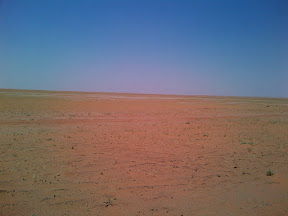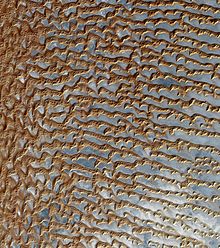In my recent trip, while going from Riyadh to Najran, we passed by World’s Largest Sand Desert ‘Rub' al Khali’ means ‘The Empty Quarter’. Although we just passed by its edge, as a whole the desert covers some 650,000 square kilometers. I was expecting it to be hardcore desert with nothing but sand, empty (as its name suggests) but to my surprise I found some strange light green colored grass and camels looked like goats while grazing in huge plains.
While reading on internet it was fascinating to find that once this area was green with 1000+ lakes, animals and humans. And only in 2006, 31 new plant species and 24 species of birds have been discovered in this region.
My Track from Riyadh to Najran
Pics: (Click to Zoom)
(Complete Pics can be seen on this link: 20130810-09 - Riyadh, Rub'al Khali, Najran and Dhahran Al Janoub)
      |
| From 20130810-09 - Riyadh, Rub'al Khali, Najran and Dhahran Al Janoub |
Pics from Internet: (Click to Zoom)
Videos from Internet: (Click for Full Screen)
The great Rub' al-Khali desert began to form more than two million years ago. It makes up about a third of Saudi Arabia and extends into both Yemen and Oman. Uninhabited one may think but the Bedu tribes have survived on the edge since before recorded time. At night billions of glittering stars light up its night sky – a feat hikers and campers, locals and expats, don’t like to miss. To say this place was once luscious green, with lakes and ponds and springs, chirping birds, grazing deer, sleeping water buffaloes, and of course devouring humans would be an unaccepted blasphemy, a madman’s dream, and a creative myth. Yet it’s all true – facts are stranger than fiction.
Terrain
The desert is 1,000 kilometers (620 mi) long, and 500 kilometers (310 mi) wide. Its surface elevation varies from 800 metres (2,600 ft) in the southwest to around sea level in the northeast. The terrain is covered with sand dunes with heights up to 250 metres (820 ft). The sand is a reddish-orange color due to the presence of feldspar. There are also brackish salt flats in some areas, such as the Umm al Samim area on the desert's eastern edge.[3]
Lake Beds
Along the middle length of the desert there are a number of raised, hardened areas of calcium carbonate, gypsum, marl, or clay that were once the site of shallow lakes. These lakes existed during periods from 6,000 to 5,000 years ago and 3,000 to 2,000 years ago. The lakes are thought to have formed as a result of "cataclysmic rainfall" similar to present-day monsoon rains and most probably lasted for only a few years. However, lakes in the Mundafen area in the southwest of the Rub' al Khali show evidence of lasting longer, up to 800 years, due to increased runoff from the Tuwaiq Escarpment.[2]
Evidence suggests that the lakes were home to a variety of flora and fauna. Fossil remains indicate the presence of several animal species, such as hippopotamus, water buffalo, and long-horned cattle. The lakes also contained small snails, ostracods, and when conditions were suitable, freshwater clams. Deposits of calcium carbonate and opal phytoliths indicate the presence of plants and algae. There is also evidence of human activity dating from 3,000 to 2,000 years ago, including chipped flint tools, but no actual human remains have been found.[2]
Climate
The region is classified as "hyper-arid", with typical annual rainfall of less than 30 millimetres (1.2 in). Daily maximum temperatures average at 47 °C (117 °F) and can reach as high as 56 °C (133 °F).[3]
Biodiversity
Fauna includes arachnids (e.g. scorpions) and rodents, while plants live throughout the Empty Quarter. As an ecoregion, the Rub' al Khali falls within the Arabian Desert and East Saharo-Arabian xeric shrublands.[3]
Oil
Geologically, the Empty Quarter is the most oil-rich site in the world.[citation needed] Vast oil reserves have been discovered underneath the sand dunes. Sheyba, at the northeastern edge of the Rub' al Khali, is a major Arab light crude oil-producing site in Saudi Arabia. Ghawar, the largest oil field in the world, extends southward into the northernmost parts of the Empty Quarter.
Expeditions
The first documented journeys by non-resident explorers were made by British explorers Bertram Thomas in 1931 and St. John Philby in 1932. Between 1946 and 1950 Wilfred Thesiger crossed the area several times and mapped large parts including the mountains of Oman.
In June 1950, a US Air Force expedition crossed the Rub' al Khali from Dhahran, Saudi Arabia, to central Yemen and back[7] in trucks to collect specimens for the Smithsonian Institution and to test desert survival procedures.[8]
In 1999 Jamie Clarke became the first Westerner to cross the Empty Quarter of Arabia in fifty years. His team of six, including three Bedouin, spent 40 days crossing the desert with a caravan of 13 camels.[9]
On 25 February 2006, a scientific excursion organized by the Saudi Geological Survey began to explore the Empty Quarter. The expedition consisted of 89 environmentalists, geologists and scientists from Saudi Arabia and abroad. Various types of fossilized creatures as well as meteorites were discovered in the desert. The expedition discovered 31 new plant species and plant varieties, as well as 24 species of birds that inhabit the region, which fascinated scientists as to how they have survived under the harsh conditions of the Empty Quarter.[10]
In 2012, Alastair Humphreys and Leon McCarron pulled a specially designed cart from Salalah to Dubai.[11] They produced a documentary film about their journey and how it compared to those of Wilfred Thesiger [12]
On 4 February 2013, a South African team including Alex Harris, Marco Broccardo and David Joyce became the first people to cross the Empty Quarter unsupported and on foot,[13] in a journey which started in Salalah and lasted 40 days, eventually ending in Dubai. The team only made use of three water stops along the journey, and pulled a specially designed cart which housed all the supplies necessary for the entire expedition.[14]
A very nice article can be found on this link: http://www.sidetracked.co.uk/edition-08/oman.php
References:
http://en.wikipedia.org/wiki/Rub'_al_Khali
http://www.wisegeek.com/what-is-the-rub-al-khali.htm
http://www.saudiaramcoworld.com/issue/198903/lakes.of.the.rub.al-khali.htm
-urShadow





No comments:
Post a Comment